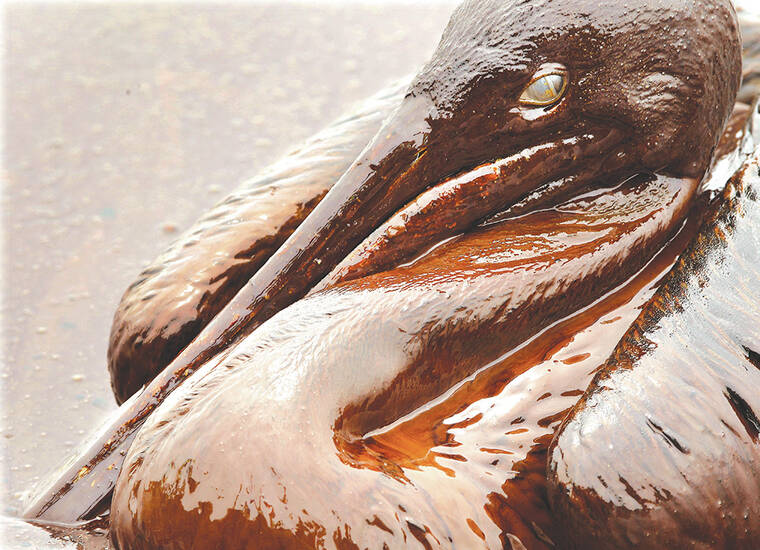When the BP Deepwater Horizon drilling rig exploded in 2010 and spewed many millions of gallons of oil into the Gulf of Mexico, the disastrous spill damaged the economy, devastated the environment and required thousands of regular people to help clean it up.
Those hired workers picked up tar balls on the beach, deployed booms from boats to soak up oil and rescued injured wildlife.
Many of them got sick, but a settlement was supposed to help.
BP agreed to pay workers who got ill after exposure to oil and a chemical dispersant used to break it up. Early on, the settlement was praised by attorneys for workers and BP as a fair solution that would provide money to victims without placing too much burden on them to prove their claims.
The Associated Press found that in practice the settlement didn’t work out that way. A smaller number of people than hoped got paid — and it was less money than they expected.
Thousands later were forced to file federal lawsuits that have been dismissed in batches across the South. The AP found just one person, boat captain John Maas, who sued and successfully settled with BP.
How people get sick from an oil spill
To break up the oil, roughly 1.8 million gallons of the dispersant Corexit were dropped from planes and sprayed from boats. Research has found it can damage cells that protect airways and cause scarring that narrows breathing tubes, making it harder to breathe over time.
Plus, oil itself is linked to illness. One of its toxic components is benzene, which can cause conditions ranging from skin irritation to cancer.
Major studies, including by the National Institutes of Health, have found that workers exposed to oil were more likely to experience dizziness, nausea, lung problems and heart attacks.
The first big problem
At the most basic level, workers and residents could submit affidavits attesting to their medical problems and collect $1,300. The vast majority of those compensated, just under 80%, got this lowest award.
People with long-term illnesses backed up by medical tests could collect up to $60,700, or more if they’d been hospitalized. But almost no one had this medical proof at the time the settlement was approved in early 2013. This became glaringly apparent the next year when BP and the workers’ attorneys had a disagreement over a key date.
BP argued that anyone without a diagnosis before April 12, 2012 couldn’t be paid through the routine claims process. Instead, they would fall into a category of people with “later manifested” conditions who would need to file individual lawsuits for compensation.
Workers’ attorneys disputed that, saying the category was meant only for people whose illnesses showed up several years after the spill, such as any who developed cancer.
U.S. District Judge Carl Barbier said that when he initially approved the settlement, he didn’t expect it to force large numbers of people to file lawsuits. In the end, however, he sided with BP, ruling that the settlement’s wording made anyone diagnosed after the 2012 date ineligible for a payout after filing a claim.
That ruling threw thousands of workers out of the settlement’s relatively easy claims process and into federal courts throughout the South.
Thrown out of court
Workers have fared poorly in federal court.
The Nations Law Firm, for example, represented huge numbers of workers and had collected medical evidence believing that would help clients receive more than the settlement’s $1,300 minimum through the claims process.
But when those workers were forced to file lawsuits, BP alleged in a Mississippi federal court that the firm manufactured medical diagnoses. Then Nations agreed to dismiss cases by the dozens. In an interview, Nations did not deny BP’s allegations but said the cases were unwinnable without an adequate expert witness.
It was also hard for workers to convince courts that the scientific evidence was strong enough to show they were exposed to enough oil and dispersant to likely cause their illness.
The workers’ experts relied on studies, such as those from the National Institutes of Health, that found people exposed to oil and Corexit were more likely to develop certain illnesses.
But BP’s experts argued individual workers needed to show exactly how much oil and dispersant they had inhaled or ingested and that it was sufficient to cause their sickness.
BP also poked holes in professional histories and work of some experts put forward by workers’ attorneys. And some law firms with hundreds of cases buckled under the strain, begging judges for more time so overloaded experts could produce reports.
Most judges have sided with BP, rejecting workers’ experts as unreliable, effectively ending the cases.
Looking ahead
The Downs Law Group, which has lost hundreds of cases against BP, is pursuing appeals in two federal circuit courts, hoping they’ll rule district judges have misconstrued the level of proof needed for toxic exposure cases. One of those judges said the issue is “very ripe for the Supreme Court to resolve.”
“It has a broader reach than the BP oil spill,” said Jason Clark, a Downs attorney. “If the burden is one that’s too high for any plaintiff to meet, then a lot of people who are exposed … are never going to see justice.”


